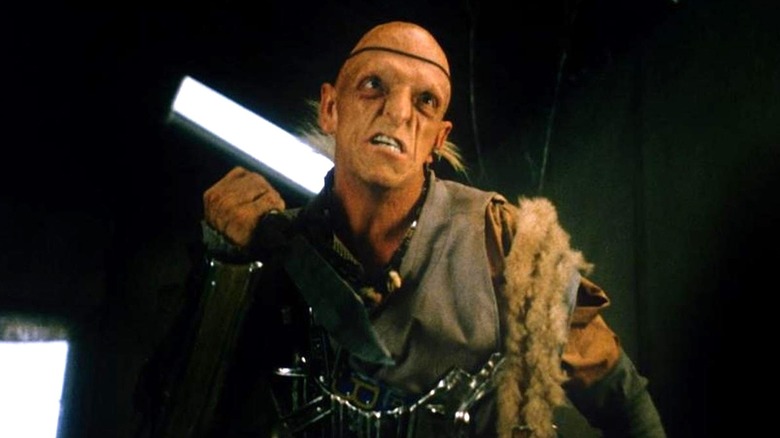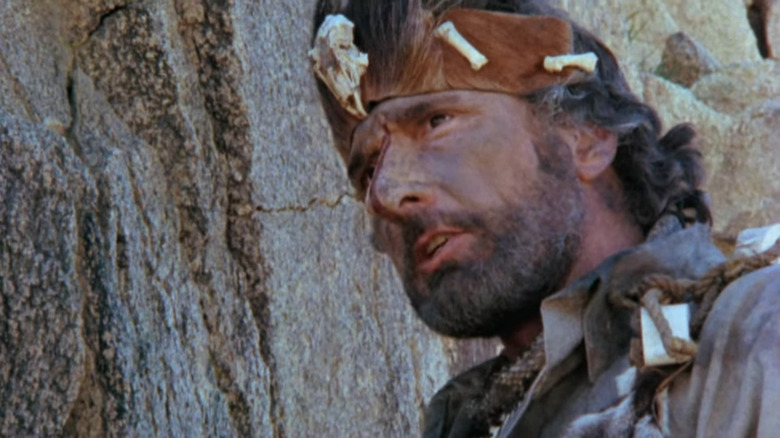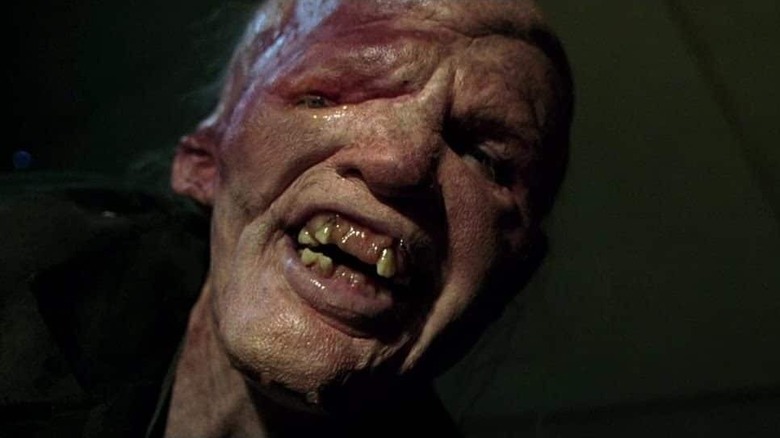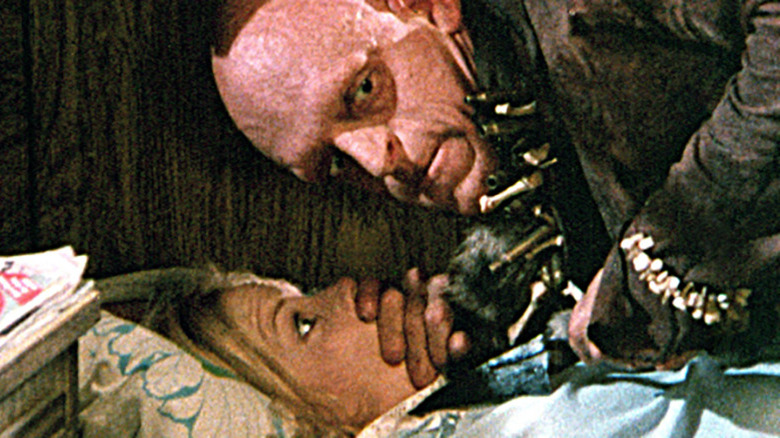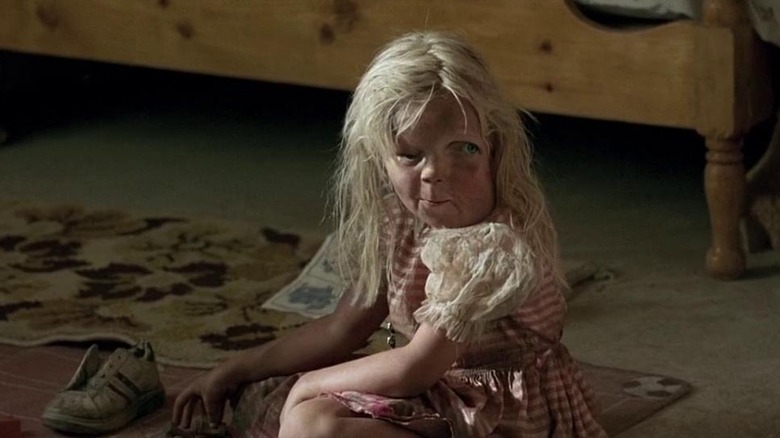The Hills Have Eyes Is Actually Based On This Creepy Real-Life Story
We may receive a commission on purchases made from links.
When a horror movie has that "based on a true story" tagline — think "Open Water" and the real events that inspired it — it automatically pricks up my ears and unsettles me half to death. I don't care how or when or why the actual story took place, just that it did. That makes all the difference. It is because of this that I truly hate to inform you that "The Hills Have Eyes" is one of those "based on a true story" horror films. Yeah, I'm sorry to be the bearer of bad, scary news.
Wes Craven, writer-director of the original 1977 film, opened up about the movie's sinister origins to Horror.com in 2006:
"Originally, it came from an article I saw in the New York library about the Sawney Bean Family. In the 1700s in Scotland I believe, there was an area that had road running through it from Scotland, and people thought it was haunted because people kept disappearing from that road. The story came out when a couple was attacked by these wild looking people, and one got away. He knew someone in the court, and they sent out an expedition which resulted in finding a cave along the English Channel."
It should be noted that while Craven says "1700s" in the quote above, it's commonly believed that the stories originated in the 1600s. It's also important to note that historians have heavily debated and disputed Bean's story and consider it to be more lore than reality. Nevertheless, the story of Sawney Bean really encapsulates the dark spirit of both the '77 original and the 2006 remake.
The story behind The Hills Have Eyes
According to legend, Sawney Bean was born in East Lothian, Scotland. His father raised him while working as a hedge trimmer and ditch digger. Though the son planned to follow in his father's footsteps for work, Bean ended up with "Black" Agnes Douglas, a woman who shared his taste for human flesh and carnage. They began living in a cave together near the Galloway coast, which was far away from the world of normal folk — and that allowed for their cannibalistic tendencies to spawn.
The exact number of children and grandchildren the pair raised in the cave is unknown, but over the 25 years they called it home, it is believed they raised and cohabitated with nearly 50 family members. The clan, much like the families featured in the films, would make meals out of clueless travelers who unfortunately came across their hunting grounds. They would capture people by night and dismember their victims in the cave before pickling, salting and eating the body parts. It's alleged that the family murdered and ate upwards of a thousand human beings over the years without ever visiting any neighboring villages.
What happened to Sawney Bean
At one point, one of the family's victims escaped and lived — which prompted King James to send troops to find the cannibalistic group. According to Alexander Smith's 1719 book "A Complete History of the Lives and Robberies of the Most Notorious Highwaymen," a man and his wife were attacked by the family during a journey on horseback. Sadly, the wife did not make it through the ambush.
"The female cannibals cut her throat and fell to sucking her blood with as great a gust as if it had been wine.
"This done, they ripped up her belly and pulled out all her entrails. Such a dreadful spectacle made the man make the more obstinate resistance, as expecting the same fate if he fell into their hands."
The monarch led a group of 400 men, according to the book, to the caves, where they found horrors beyond their comprehension.
"Now the whole body, or as many of them as could, went in, and were all so shocked at what they beheld that they were almost ready to sink into the earth. Legs, arms, thighs, hands and feet of men, women and children were hung up in rows, like dried beef.
"A great many limbs lay in pickle, and a great mass of money, both gold and silver, with watches, rings, swords, pistols, and a large quantity of clothes, both linen and woollen, and an infinite number of other things, which they had taken from those whom they had murdered, were thrown together in heaps, or hung up against the sides of the den."
From there, the family was taken into custody by the monarchy and executed for their crimes against humanity. That said, historians are not confident that Bean's family ever actually existed, so despite "The Hills Have Eyes" garnering that coveted "based on a true story" status, this may all just be an interesting legend passed down over time. Great inspiration, though.
Why Sawney Bean's story inspired Wes Craven
Ahead of the film's original 1977 release, Craven spoke with ARROW about the Bean family — and even touched on the way they were executed and how their horrific actions mirrored society at the time:
"They did horrendous things to them. Broke them all on the wheel. Hanged the women in front of the men and then they dismembered the men. And I was so struck by how on the one hand you have this feral family that's killing people and eating them.
"But if you look at it they weren't doing anything that much worse than civilization did when they caught them. And I just thought what a great kind of A/B of culture. How the most civilized can be the most savage and how the most savage can be civilized.
"I constructed these two families as mirrors of each other. I found it very interesting to look at ourselves, to think of ourselves as having the capacity not only for great good, but for great evil."
Film writer John Wooley Wiley also discussed Craven's motives for updating the Bean family story to the modern-day in his 2011 book, "Wes Craven: The Man and his Monsters":
"Craven realized that by updating the Sawney Bean story to 20th century California, he would have the opportunity not only to comment on a cult society dwelling inside modern civilization, but also the chance to comment on that civilization's less-than-civilized retribution against the cannibals."
The Hills Have Eyes remake was based on two horrifying true stories
While historians debate whether or not Sawney Bean actually existed and committed those atrocious crimes, the legend has definitely left its impact on scary cinema. However, there are two other stories that inspired the 2006 "Hills Have Eyes" remake and are — sadly — 100% true.
Yes, the "Hills Have Eyes" movies share key story components and tone, but in the early aughts version directed by Alexandre Aja, the homicidal family is plagued by physical deformities due to nuclear testing in a mining town, which was later covered by up the U.S. government. Nuclear power gone wrong has long been a staple of horror thanks to real-world tragedies, and those same incidents also impacted 2006's "The Hills Have Eyes."
"We based all our descriptions and directions on real documents, pictures, and footage that we found on the effects of nuclear fallout in Chernobyl and Hiroshima," Alexandre Aja said in "The Making Of," a behind-the-scenes featurette about his version of the movie. Needless to say, Hiroshima and Chernobyl are basically real-life horror stories, and the nightmarish power of nuclear energy certainly roots the remake in reality.
